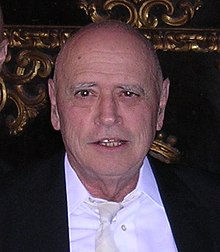Sylvano Bussotti

This article has multiple issues. Please help improve it or discuss these issues on the talk page. (Learn how and when to remove these messages)
|
Sylvano Bussotti (born 1 October 1931) is an Italian composer of contemporary classical music. His work uses unusual notation, which often creates special problems of interpretation.
Life and career
Born in Florence, Bussotti learned to play the violin as a child, becoming a prodigy. Later he studied at the Florence Conservatory (where he developed an opposition to modernism), with Luigi Dallapiccola and with Max Deutsch in Paris. As a composer he was influenced by the twelve-tone music of Webern and later John Cage. Examples of his use of graphic notation in his pieces, often reflecting his personal life, include Lorenzaccio and La passion selon Sade. He pursues other disciplines including painting, graphic art, and journalism.
Bussotti is also a well-known film director, actor, and singer. His uncle Tono Zancanaro and his older brother Renzo Bussotti strongly influenced his style in painting. He has written most of the librettos of his operas. As a writer, his style is considered one of the most refined among the Italian poets and novelists of the 20th century. French culture has fascinated him since he was a boy. His great friend Cathy Berberian (Luciano Berio's wife) was one of his most famous interpreters. He was, or is, well acquainted with writers and film directors Aldo Palazzeschi, Pier Paolo Pasolini, Derek Jarman, Elsa Morante, Alberto Moravia, Aldo Braibanti, Mario Zanzotto, Fabio Casadei Turroni, Dacia Maraini, and Umberto Eco. Derek Jarman was the director of his opera L'Ispirazione, first staged in Florence in 1988. Rara Film is his most celebrated underground film. The film, according to the author's instructions, should be performed, together with the score, which includes from seven to eleven players. The music of Rara Film is not a strict counterpoint of the film, flowing without any relation to the images.
He has served as the artistic director of La Fenice, Venice. As a personality he is notoriously flamboyant and occasionally shocking. He staged a high-profile resignation from the Venice Biennale in 1991 by bringing in a famous prostitute to give the keynote speech. Outspoken and openly gay, Bussotti expressed his sexuality in his music as early as 1958.[1]
Works
Music
|
Novels and poems
|
References
- ^ Attinello, Paul (2002), "Bussotti, Sylvano", glbtq.com
Further reading
- Attinello, Paul. Signifying Chaos: A Semiotic Analysis of Sylvano Bussotti's "Siciliano", in: repercussions 1 (1992), pp. 84–110.
- Bortolotto, Mario. Fase seconda. Studi sulla Nuova Musica, Einaudi, Turin 1969. [especially the chapter "Le cinque tentazioni di Bussotti", pp. 201–226.]
- Bortolotto, Mario (ed.). "Sognato dalla storia": materiali per un "Lorenzaccio", in: Lo Spettatore musicale, Sonderheft, Bologna 1972 [with contributions from Mario Bortolotto, Giorgio Manganelli, and Salvatore Sciarrino].
- Bucci, Moreno (ed.). L'opera di Sylvano Bussotti. Musica, segno, immagine, progetto. Il teatro, le scene, i costumi, gli attrezzi ed i capricci dagli anni Quaranta al BUSSOTTIOPERABALLET, Electa editrice, Milano 1988.
- Degrada, Francesco (ed.). Bussottioperaballet: Sylvano Bussotti e il suo teatro: Oggetto amato ─ Nottetempo, Ricordi, Milan, 1976; [Bussotti: Cinque frammenti autobiografici, p. 13, the libretto of "Nottetempo", interviews and essays].
- La Face, Giuseppina. Teatro, eros e segno nell'opera di Sylvano Bussotti, in: Rivista Italiana di Musicologia 9 (1974), pp. 250–268.
- Lucioli, Alessandra. Sylvano Bussotti, Targa Italiana Editrice, Milan, 1988.
- Maehder, Jürgen, and Sylvano Bussotti. Turandot, Pisa (Giardini) 1983.
- Maehder, Jürgen. BUSSOTTIOPERABALLET ─ Sviluppi della drammaturgia musicale bussottiana, in: Nuova Rivista Musicale Italiana 18 (1984), pp. 441–468.
- Maehder, Jürgen. BUSSOTTIOPERABALLET ─ Zur Entwicklung der musikalischen Dramaturgie im Werk Sylvano Bussottis, in: Otto Kolleritsch (ed.), Oper heute. Formen der Wirklichkeit im zeitgenössischen Musiktheater, Studien zur Wertungsforschung vol. 16, Universal Edition, Vienna and Graz, 1985, pp. 188–216.
- Maehder, Jürgen. "Odo un Sylvano" ─ Zur Rolle des Komponisten, Regisseurs, Bühnen-und Kostümbildners Sylvano Bussotti im zeitgenössischen Musiktheater, Programmheft der Frankfurter Feste, Alte Oper, Frankfurt 1991, pp. 16–63.
- Maehder, Jürgen. ""Bussotti, Sylvano". The New Grove Dictionary of Opera, 4 vols., edited by Stanley Sadie. London: Macmillan Publishers, 1992.
- Maehder, Jürgen. Zitat, Collage, Palimpsest ─ Zur Textbasis des Musiktheaters bei Luciano Berio und Sylvano Bussotti, in Hermann Danuser and Matthias Kassel (eds.), Musiktheater heute. Internationales Symposion der Paul Sacher Stiftung Basel 2001, Schott, Mainz 2003, p. 97–133.
- Morini, Luciano. Moda e musica nei costumi di Sylvano Bussotti, Idealibri, Milan 1984; German edition: Aldo Premoli/Luciano Morini: Träume in Samt und Seide. Mystik und Realität in den Opernkostümen des Sylvano Bussotti, Edition Wissenschaft & Literatur, Marketing-und-Wirtschaft Verlagsgesellschaft Flade, Munich 1985, ISBN 3-922804-09-8.
- Osmond-Smith, David. "Bussotti, Sylvano". The New Grove Dictionary of Music and Musicians, second edition, edited by Stanley Sadie and John Tyrrell. London: Macmillan Publishers, 2001.
- Pinzauti, Leonardo. A colloquio con Sylvano Bussotti, in: Nuova Rivista Musicale Italiana 4/1970, pp. 898–909.
- Stoïanova, Ivanka. Geste ─ texte ─ musique, Éditions 10/18, Paris 1978.
- Stoïanova, Ivanka. Mythos und Gedächtnis. Bemerkungen über das italienische Musiktheater: Luciano Berio ─ "Outis" und Sylvano Bussotti ─ "Tieste", in: Otto Kolleritsch (ed.), Das Musiktheater ─ Exempel der Kunst, Studien zur Wertungsforschung vol. 38, Universal Edition, Vienna and Graz, 2001, pp. 161–191.
- Stoïanova, Ivanka. Entre détermination et aventure. Essais sur la musique de la deuxième moitié du XXeme siècle, L'Harmattan, Paris, 2004.
- Stoïanova, Ivanka. Sylvano Bussotti: B. O. B.—Bussottioperaballet/Stratégies dissipatives dans "Questo fauno" et "Tieste". In Musiques vocales en Italie depuis 1945, edited by Pierre Michel and Gianmario Borio, pp. 29–60. Collection Recherche, edited by Sophie Stevance. Notre Dame de Bliquetuit: Millénaire III Éditions, 2005. ISBN 2-911906-11-X.
External links
- Use dmy dates from June 2013
- 1931 births
- 20th-century classical composers
- 21st-century classical composers
- Italian classical composers
- Italian male classical composers
- LGBT classical composers
- LGBT musicians from Italy
- Living people
- Musicians from Florence
- Pupils of Karlheinz Stockhausen
- 20th-century Italian composers
- Pupils of Max Deutsch
- 20th-century Italian male musicians
- 21st-century male musicians
